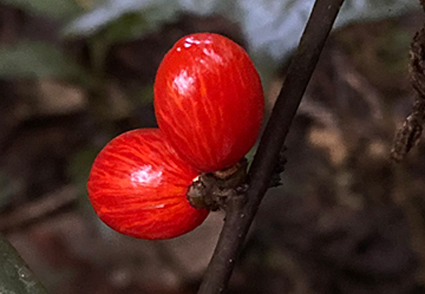Abstract
A new species of Celastraceae, Microtropis gulinqingensis, is discovered in the dynamic plot of Gulinqing Provincial Nature Reserve, Yunnan Province, China. After two-year observations of 65 individual plants in the field, we found that this species presented unique traits of being dioecious and having highly connate petals in its male flowers. We compared it with similar species and those in Microtropis distributed across the adjacent regions, and the morphological evidence supports the recognition of Microtropis gulinqingensis as a new species. A comprehensive description and photographs of this new species are provided.
References
- Cheng, C.Y., Kao, T.C., Ma, Q.S., Ma, J.S. & Huang, P.H. (1999) Celastraceae. In: Cheng, C.Y. & Huang, P.H. (Eds.) Flora Reipublicae Popularis Sinicae, 45 (3). Science Press, Beijing, pp. 1–206. [in Chinese]
- Dunn, T.S. (1908) A botanical expedition to central Fokien. The Journal of the Linnean Society. Botany 38: 357. https://doi.org/10.1111/j.1095-8339.1908.tb00858.x
- Fan, G.S. (2006) Microtropis. In: Wu, C.Y. (Ed.) Flora of Yunnanica, Tomus 16. Science Press, Beijing, pp. 254–267. [in Chinese]
- Hallier, H. (1911) Ueber Phanerogamen von unsicherer oder unrichtiger Stellung. Mededeelingen van’s Rijks Herbarium 1: 33.
- Harris, J.G. & Harris, M.W. (2001) Plant identification terminology: an illustrated glossary. second edition. Spring Lake Publishing, Utah, 182 pp.
- Hou, D. (1962) Celastraceae I. In: van Steenis, C.G.G.J. (Ed.) Flora Malesiana Ser. I, 6 (2). Noordhoff-Kolff, Djakarta, pp. 272–280.
- IUCN (2024) The IUCN red list of threatened species. Version 2024-1. Available from: https://www.iucnredlist.org/ (Accessed: 09 July 2024).
- Lin, Q.W. & Zhang, Z.X. (2008) A new species of Microtropis (Celastraceae) from Xizang, China. Novon 18 (4): 488–500. https://doi.org/10.3417/2007012
- Lin, Q.W. & Zhang, Z.X. (2010) Microtropis longicarpa and M. daweishanensis (Celastraceae), two new species from Yunnan, China. Annales Botanici Fennici 47 (2): 141–147. https://doi.org/10.5735/085.047.0210
- Lin, Q.W. (2009) A taxonomic revision of Microtropis (Celastraceae). Beijing Forestry University, Beijing, PhD thesis, pp. 1–352 [in Chinese]
- Liu, Q., Chen, W.H., Huang, H., Yang, C., Fan, C.L., Zhang, J.G & Shui, Y.M. (2024) Floristic geography of woody plants in the big plot of Gulinqing karst forest in Yunnan Province. Guihaia.
- Loesener, L.E.T. (1897) Undescribed plants from central America. Botanical Gazette 24: 393–394.
- Meisner, C.F. (1837) Plantarum vascularium genera, secundum ordines naturales digesta eorumque differentiae et affinitates tabulis diagnostacis expositae. commentarius. Libraria Weidmannia, Lipsia, 49 pp. https://doi.org/10.5962/bhl.title.44043
- Merrill, E.D. & Freeman, F.L. (1940) The Old World species of the Celastraceous genus Microtropis Wallich. Proceedings of the American Academy of Arts and Sciences 73: 271–310. https://doi.org/10.2307/25130189
- POWO (2024) Plants of the World Online. Facilitated by the Royal Botanic Gardens, Kew. Available from: http://www.plantsoftheworldonline.org/ (accessed 6 July 2024)
- Savinov, I.A. (2007) Some morphological basics for a revision of the tribe Euonymeae Loes. (Celastraceae R.Br.). Wulfenia 14: 97–104.
- Savinov, I.A., Nuraliev, M.S., Kuznetsov, A.N., Kuznetsova, S.P., Luu, H.T., Tran, H.D. & Luong, H.T. (2019) Microtropis cerocarpa (Celastraceae), a new species from southern Vietnam. Phytotaxa 387 (2): 140–148. https://doi.org/10.11646/phytotaxa.387.2.6
- Shui, Y.M. & Chen, W.H. (2002a) A new species of the genus Microtropis (Celastraceae) from SE Yunnan, China. Acta Botanica Yunnanica 24 (6): 707–708.
- Shui, Y.M. & Chen, W.H. (2002b) Microtropis (Celastraceae) from the Daweishan Range, SE Yunnan, China. Botanical Bulletin of Academia Sinica 43: 305–312.
- Sprague, T.A. (1909) The American Species of Microtropis. Kew Bulletin 1909: 363–364. https://doi.org/10.2307/4113321
- Symington, C.F. (1936) The flora of Gunong Tapis in Pahang: with notes on the altitudinal zonation of the forests of the Malay peninsula. Journal of the Malayan Branch of the Royal Asiatic Society 14 (3 (126)): 350. [http://www.jstor.org/stable/41559878]
- Wight, R. (1845) Icones Plantarum Indiae Orientalis or figures of Indian Plants. Athenrum Press, Madras, pp. 975–1052.
- Xuan, J. (2009) Molecular Systematics Study on Microtropis (Celastraceae) in China. Beijing Forestry University, M.S. thesis, Beijing, pp. 1–4.
- Zhang, Z.X. & Funston, A.M. (2008) Microtropis. In: Wu, Z.Y., Raven, P.H. & Hong, D.Y. (Eds.) Flora of China, vol. 11. Science Press and Missouri Botanical Garden, Beijing and St. Louis, pp. 479–486.


